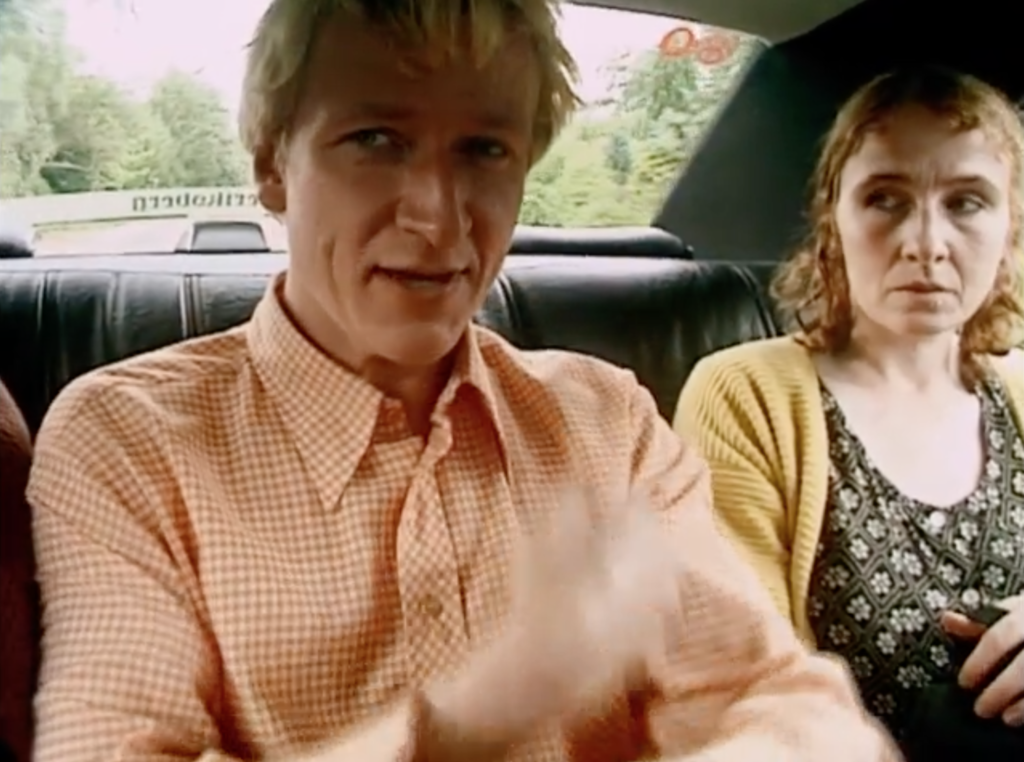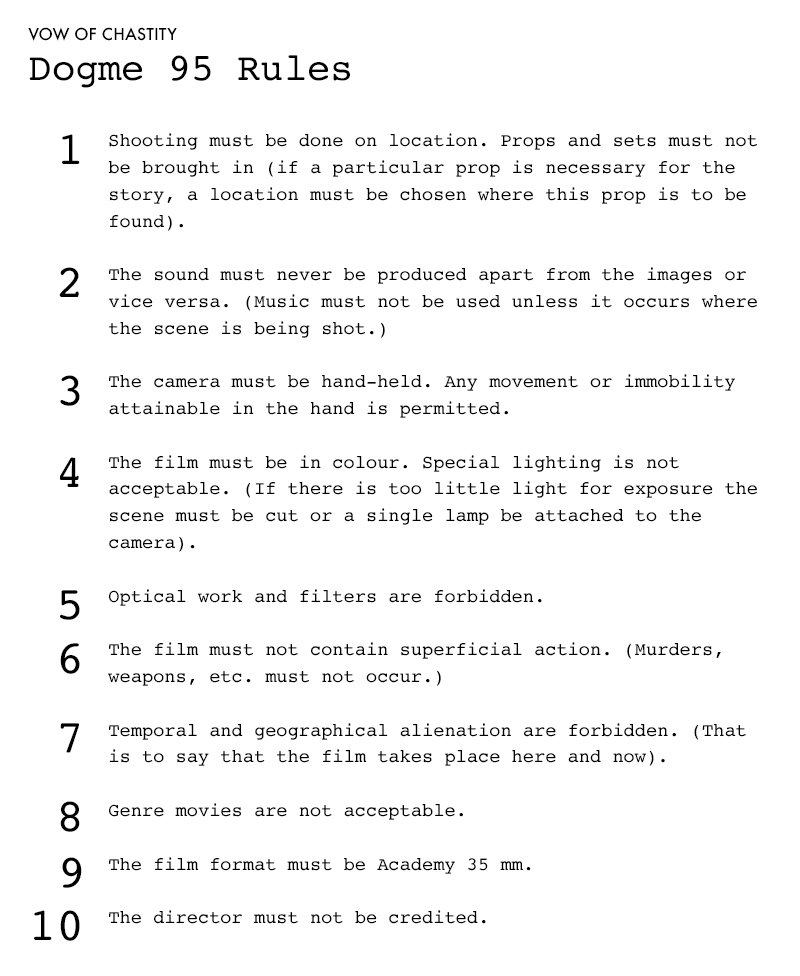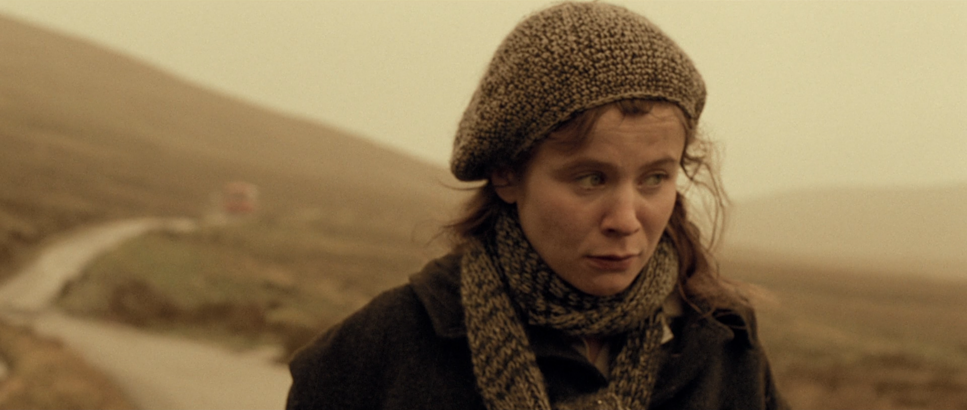Dogme 95, a film movement founded by Danish directors Lars von Trier and Thomas Vinterberg in 1995, revolutionized the cinematic landscape with its raw, minimalistic approach to storytelling. This avant-garde movement, also known as dogma 95, dogme95, dogma95, or simply “Dogme,” sought to simplify filmmaking to its core essentials, rejecting the artifice of mainstream cinema.
The significance of Dogme 95 lies in its challenge to conventional filmmaking techniques and its emphasis on authenticity, realism, and the power of storytelling. The movement’s influence extended beyond Denmark, inspiring filmmakers worldwide to embrace a more honest and stripped-down approach to cinema.
This article will explore the founding of Dogme 95, its core principles, influential films, global impact, controversies, and lasting legacy, arguing that the movement’s pursuit of cinematic truth continues to resonate with filmmakers and audiences alike.

Table of Contents
Background and Context
In the 1990s, cinema was dominated by big-budget productions, special effects, and a focus on visual spectacle over storytelling. Dogme 95 emerged as a response to this trend, seeking to bring filmmaking back to its roots and emphasize the human experience over artificial movie magic.
Dogme 95 drew inspiration from various sources, including the French New Wave, cinéma vérité, and the works of directors like John Cassavetes and Ingmar Bergman. These influences shaped the movement’s emphasis on realism and natural performances.
Lars von Trier and Thomas Vinterberg, two Danish filmmakers, were the key figures behind Dogme 95. Both had already established themselves as innovative and provocative directors, with films like von Trier’s “Europa” and Vinterberg’s “The Greatest Heroes.” Their collaboration writing the Dogme 95 manifesto would cement their status as trailblazers in cinema.
The Dogme 95 Manifesto
The Dogme 95 manifesto, known as the “Vow of Chastity.” This set of ten strict rules challenged conventional filmmaking techniques, emphasizing realism, natural lighting, handheld camerawork, and authentic performances. The rules included shooting on location, using only natural light, capturing sound directly on set, and prohibiting the use of props, sets, and non-diegetic music.
The purpose of the “Vow of Chastity” was to strip away the artificiality of modern cinema and force filmmakers to focus on the essentials of storytelling. By adhering to these rules, Dogme directors sought to create a more honest and immersive cinematic experience, one that would engage viewers on a deeper, more emotional level.
The implications of the Dogme 95 rules were far-reaching, affecting every aspect of the filmmaking process. Directors had to adapt to a more spontaneous and improvisational style, actors were required to deliver raw and authentic performances, and cinematographers had to rely on natural light and handheld cameras to capture the truth of each moment.

Influential Dogme 95 Films
Thomas Vinterberg’s “Festen” (The Celebration) was one of the first and most acclaimed Dogme 95 films. The story of a family reunion that descends into chaos when dark secrets are revealed, “Festen” embodied the movement’s principles to create a sense of raw authenticity. The film’s success at the Cannes Film Festival helped put Dogme 95 on the international map.
Lars von Trier’s “Idioterne” (The Idiots) was another seminal Dogme 95 work. The film follows a group of young people who pretend to be mentally disabled as a form of social commentary and personal exploration. “Idioterne” pushed the boundaries of the Dogme 95 rules, incorporating elements of improvisation and provocation to challenge viewers’ expectations and preconceptions.
Other notable Dogme 95 films include Søren Kragh-Jacobsen’s “Mifunes sidste sang” (Mifune’s Last Song), Lone Scherfig’s “Italiensk for begyndere” (Italian for Beginners), and Jean-Marc Barr’s “Lovers.” These films showcase the diversity of stories and styles that emerged from the movement, each adhering to the “Vow of Chastity” while exploring different themes.

Global Impact and Influence
Dogme 95’s influence quickly spread beyond Denmark, with filmmakers around the world embracing the movement’s principles. Directors like Harmony Korine (USA), Jean-Marc Barr (France), and José Luis Marquès (Argentina) created their own Dogme 95-inspired films, adapting the rules to suit their unique cultural and artistic contexts.
The Dogme 95 movement had a significant impact on independent and low-budget filmmaking. By demonstrating that powerful, emotionally resonant stories could be told without the need for expensive sets, special effects, or large crews, Dogme 95 inspired a new generation of filmmakers to experiment with minimalist techniques and focus on the essentials of storytelling.
Dogme 95 also played a crucial role in the rise of digital filmmaking. The movement lent itself well to the use of digital video, which was becoming increasingly accessible and affordable in the late 1990s and early 2000s. Many Dogme 95 films were shot on digital cameras, paving the way for the digital cinema that would shift the film industry in the years to come.
Criticisms and Controversies
Despite its influence and acclaim, Dogme 95 was not without its critics. Some reviewers accused the movement of being gimmicky and pretentious, arguing that the strict rules of the “Vow of Chastity” were more of a publicity stunt than a genuine artistic statement. Others felt that the Dogme 95 films were too raw and unpolished, lacking the visual and narrative sophistication of more traditional cinema.
There were also controversies surrounding the Dogme 95 founders themselves. Both Lars von Trier and Thomas Vinterberg admitted to breaking some of the rules in their own films, leading to accusations of hypocrisy and questions about the authenticity of the movement as a whole.
Despite these criticisms and controversies, the impact of Dogme 95 cannot be denied. The movement sparked a global conversation about the nature of cinema and the role of the filmmaker, challenging long-held assumptions about what constitutes “good” filmmaking and paving the way for a new era of experimentation and innovation in the medium.
Broader Cultural Impact
The influence of Dogme 95 extended beyond cinema, inspiring artists and cultural movements across a range of disciplines. In the field of architecture, for example, the “dogma” philosophy of simplicity and authenticity found expression in the minimalist designs of architects like Bjarke Ingels and Thomas Heatherwick.
In culinary, the New Nordic Kitchen movement, led by chefs like René Redzepi and Claus Meyer, drew inspiration from the Dogme 95 ethos of authenticity and local sourcing. Just as Dogme 95 filmmakers sought to capture the truth of a particular time and place, New Nordic chefs aimed to create dishes that reflected the unique terroir and culture of Scandinavia.
The term “dogma” itself became a buzzword in the late 1990s and early 2000s, used to describe any artistic or cultural movement that emphasized authenticity, simplicity, and a rejection of artifice. From “dogma design” to “dogma fashion,” the Dogme 95 philosophy had a ripple effect that extended far beyond cinema.

Decline and Legacy
By the early 2000s, the Dogme 95 movement had begun to lose steam. Many of the original founders, including Lars von Trier and Thomas Vinterberg, had moved on to other projects and styles, and the strict rules of the “Vow of Chastity” were increasingly seen as more of a hindrance than a source of inspiration. In 2005, on the tenth anniversary of the movement’s founding, the Dogme 95 collective officially disbanded.
Despite its relatively short lifespan, the impact of Dogme 95 cannot be overstated. The movement’s emphasis on authenticity, simplicity, and the power of storytelling continue to influence filmmakers around the world, from low-budget independent productions to big-budget Hollywood features.
The legacy of Dogme 95 can be seen in the continued popularity of handheld camerawork, natural lighting, and improvised performances in contemporary cinema. It can also be seen in the ongoing debate about the role of technology and artifice in filmmaking (particularly as Artificial Intelligence becomes more embedded in our culture), and the search for new ways to capture the truth of the human experience on screen.
Conclusion
Dogme 95 was a radical filmmaking movement that challenged the conventions of cinema and inspired a new generation of filmmakers around the world. Its emphasis on authenticity, simplicity, and the power of storytelling, the movement helped to redefine what was possible for filmmakers.
While the strict rules of the “Vow of Chastity” may have been difficult to sustain over the long term, the core principles of Dogme 95 continue to resonate with filmmakers and audiences alike. The movement’s legacy can be seen in the continued popularity of minimalist techniques, the emphasis on performance over spectacle, and the ongoing search for truth and authenticity in cinema.
As we continue to grapple with the role of technology and artifice in our lives, the lessons of Dogme 95 remain as relevant as ever. By stripping away the layers of artificiality and focusing on the essentials of human experience, the movement offers a roadmap for a more honest and authentic kind of storytelling – one that has the power to transform both the medium of film and the world around us.
Dogme 95 Films
- The Celebration (1998)
- The Idiots (1998)
- Mifune (1999)
- The King Is Alive (2000)
- Lovers (1999)
- Julien Donkey-Boy (1999)
- Interview (2000)
- Fuckland (2000)
- Babylon (2001)
- Chetzemoka’s Curse (2001)
- Diapason (2001)
- Italian for Beginners (2000)
- Amerikana (2001)
- Joy Ride (2000)
- Camera (2000)
- Bad Actors (2000)
- Reunion (2001)
- Truly Human (2001)
- Cabin Fever (2000)
- Strass (2001)
- Kira’s Reason: A Love Story (2001)
- Once Upon Another Time (2000)
- Resin (2001)
- Security, Colorado (2001)
- Converging with Angels (2002)
- The Sparkle Room (2001)
- Come Now
- Open Hearts (2002)
- The Breadbasket (2002)
- Días de boda (2002)
- El desenlace (2005)
- Old, New, Borrowed and Blue (2003)
- Residencia (2004)
- In Your Hands (2004)
- Così x caso (2004)
- Amateur Dramatics
- Gypo (2005)
- Mere Players
- el ultimo lector
- Lazy Sunday Afternoons
- Lonely Child (2005)
- DarshaN
- 11:09
What are the core principles of Dogme 95?
The core principles of Dogme 95 are encapsulated in the “Vow of Chastity,” a set of ten rules that filmmakers must follow:
– Shooting must be done on location. Props and sets must not be brought in (if a particular prop is necessary for the story, a location must be chosen where this prop is to be found).
– The sound must never be produced apart from the images or vice versa. (Music must not be used unless it occurs where the scene is being shot.)
– The camera must be hand-held. Any movement or immobility attainable in the hand is permitted.
– The film must be in color. Special lighting is not acceptable. (If there is too little light for exposure the scene must be cut or a single lamp be attached to the camera.)
– Optical work and filters are forbidden.
– The film must not contain superficial action. (Murders, weapons, etc. must not occur.)
– Temporal and geographical alienation are forbidden. (That is to say that the film takes place here and now.)
– Genre movies are not acceptable.
– The film format must be Academy 35 mm.
– The director must not be credited.
Furthermore I swear as a director to refrain from personal taste! I am no longer an artist. I swear to refrain from creating a “work”, as I regard the instant as more important than the whole. My supreme goal is to force the truth out of my characters and settings. I swear to do so by all the means available and at the cost of any good taste and any aesthetic considerations.
What was Dogme 95 fundamentally opposing?
At its core, Dogme 95 opposed the heavily stylized, high-budget, and technology-driven filmmaking practices prevalent in the mainstream cinema of the 1990s. The movement sought to strip filmmaking down to its essentials, focusing on authentic performances, naturalistic settings, and raw storytelling, rather than relying on special effects, artificial lighting, and post-production manipulation.
Why did Dogme 95 come to an end?
Dogme 95 officially ended in 2005, a decade after its inception. The founders, Lars von Trier and Thomas Vinterberg, decided to conclude the movement because the strict adherence to the “Vow of Chastity” had begun to produce formulaic and predictable films. Despite the movement’s significant impact and initial innovative results, the rigid rules eventually became creatively constraining, leading to its dissolution.
What is the sixth rule of Dogme 95?
The sixth rule of the Dogme 95 “Vow of Chastity” states that the film must not contain superficial action, such as murders or the use of weapons. This rule is part of the larger aim to focus on authentic human emotions and interactions rather than relying on sensationalized violence or artificial plot devices. The rule also emphasizes that temporal and geographical alienation are forbidden, meaning that the film must be set in the present time and in a real, identifiable location.